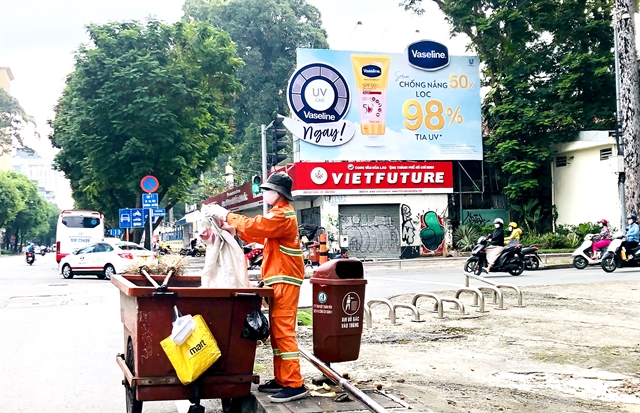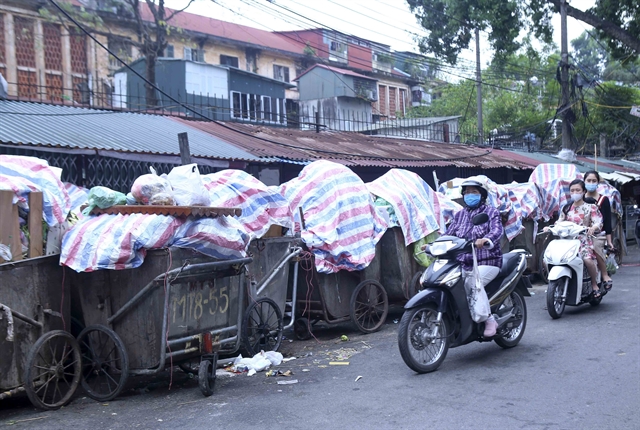 Environment
Environment

 |
| Domestic waste piled up on garbage carts near the Nam Đồng residential apartment buildings in Hà Nội. VNA/VNS Photo |
HÀ NỘI All households in Việt Nam are expected to separate their solid household waste and place it in trash bags; failure to do so could result in fines of between VNĐ500,000 and VNĐ1 million.
But as the search for appropriate solutions to classify waste at the source is still a challenge for many areas, especially for major cities like Hà Nội and HCM City, this rule is not usually well understood, even by garbage collectors.
Due to a lack of appropriate policies and solutions, many people have expressed the opinion that the sanctions imposed are irrational and inappropriate.
Some experts have said that the sanctions imposed are unreasonable and not in the right context due to the lack of proper policies and solutions.
Associate Professor Lưu Đức Hải, chairman of the Vietnam Association for Environmental Economics, said: “We continue to blame public awareness or consciousness without looking at the shortcomings in the State's strategy and regulations.”
“In a market economy, if we create infrastructure and markets for facilities that classify waste in detail, the benefits of recovered resources from waste classification at source will become the economic driving force for waste classification at source without the need for too much communication and education. I think waste is a common problem of society, so only people or businesses collecting waste cannot solve it for the reasons I mentioned above,” he told the Voice of Vietnam.
He stated that infrastructure for collection facilities at wards and hamlets must have a minimum space area of 100 to 200 sq.m. In order for those facilities to have legal status and benefit from tax incentives, the Government must be engaged. There should also be a market to trade in resource products after sorting waste.
Hải said regulations and strategies pertaining to garbage sorting at the source must be reviewed. Then scrap collectors and numerous other impoverished individuals would be willing to participate without the need for large-scale mobilisation efforts.
Since January 1, all households and individuals are required to sort their domestic solid waste. However, despite a requirement under the Law and Decree on Environmental Protection, several cities --including Hà Nội -- have yet to establish a strategy for implementing the law.
Each locality has different conditions and circumstances, but they share the same goal of bringing sorted waste products to factories or recycling facilities. Transporting sorted waste too far will be costly and reduce the benefits of classification, Hải said.
Depending on each locality’s specific conditions, such as the composition and nature of solid waste, the current status of factories and existing recycling facilities, he recommended building more facilities to regulate classification at the local level.
Hải stated: "It is necessary to pay attention to other types of solid waste like construction solid waste, livestock waste, agricultural by-products and straw. We should not think about burning waste. For example, it takes 3-4kg of wood to produce 1kg of paper. If we burn paper instead of recycling, we are wasting that resource!”
“Consider waste as a form of resource when coming up with any strategy or regulation. It is necessary to think about the implementation solutions, not just the goals. All major strategies and policies of the State need to conduct a social impact assessment before approval,” he said.
Associate Professor Bùi Thị An, director of the Institute of Natural Resources, Environment and Community Development, said implementing waste classification at the source is challenging and necessitates a suitable roadmap, but it holds significant economic potential.
Localities must examine every area in order to execute plans successfully. Examine the model in locations where garbage sorting at the source has been successful, then modify and apply these models to fit the needs of each region, she said.
This will take a lot of time and money, but if it is not done quickly, the process of classifying waste at the source will take longer and be more difficult to implement, she noted.
Associate Professor Lê Hùng Anh from the Institute of Environmental Science, Engineering and Management said: "Communication campaigns are not enough. If we step up communication without putting it into practice, it will lose its effect over time.”
In waste classification, it is important to have a suitable roadmap depending on the capacity of each locality. Instead of dividing waste into three types, initially it should only be divided into two types: recyclable and non-recyclable. In localities with waste-to-energy projects, garbage should be divided into burnable and non-burnable types. After a period of time long enough to form household habits, we should move to a more advanced and detailed stage, classifying waste into three to four types, he said.
According to Associate Professor Nguyễn Thị Ánh Tuyết, director of the School of Environmental Science and Technology at the Hanoi University of Science and Technology, in order for the integrated solid waste management system to operate effectively, there needs to be synchronisation and smooth operation at all stages, from waste generation, collection, transfer, and recycling to destruction or burial at landfill.
Although the law has taken effect, certain documents that serve as guidelines for the law require improvement, he said. VNS




